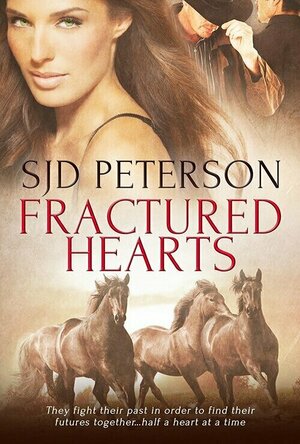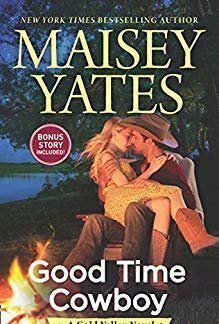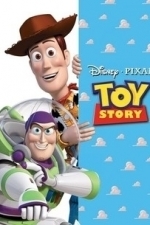
Fractured Hearts
Book
Unrequited love, two sexy cowboys and a passionate veterinarian fight their past in order to find...
Ménage Erotic Western Romance
ArecRain (8 KP) rated Corralled (Blacktop Cowboys, #1) in Books
Jan 18, 2018
Because I dont really have much to say about this book, here goes.
The good: the erotic scenes, the character development, the dialogue,
the writing
The bad: the plot (which bored me senseless), the favoritism
The ugly: the situation
While there is nothing actually wrong with the novel, I just could not get into it. James has a great easy style to read. The erotic scenes were great, some of the best I have read, especially when dealing with such an awkward situation. And oh was it awkward. The dialogue was realistic and had me not only laughing, but cringing as well. The characters and the emotions were also very believable. I found myself becoming attached to them
The plot seemed a little lackluster, however. I will gave James points for having one of the few erotic novels with a well developed plot in the first place. As I said before, however, it was just not a story I was interested in. It was clear from the beginning who the lead female was going to end up with. I dont think James did it on purpose, but her clear favoritism for one man over the other was apparent from the beginning.
This was not an easy book to read in the first place due to the circumstances of the love triangle. All of the ménage a trios novels I have read before, the couples were into it as a threesome. In this novel, two men are vying the attention and love of one woman. It was awkward at best, especially since the men were childhood friends.
Carma (21 KP) rated Good Time Cowboy (Gold Valley, #3) in Books
Jun 17, 2019
Lindy Parker is a strong woman. She wants what she wants when she wants it. She does NOT want Wyatt Dodge. Yet the same man occupies her every waking thought, her dreams and everything in between. She cant believe she is attracted to a bull rider.
Wyatt Dodge has been attracted to Lindy Parker for 5 years. Since the first day he saw her walking toward him only to kiss his friend Damien and get introduced as his wife. He cant do anything about said attraction with his ranch on the line. He has to find a way to work with her on the upcoming grand opening of his dude ranch or it will all be for nothing.
Lindy likes to be in charge, she likes order and structure. Everything Wyatt is not. Working with him is going to test her patience in more ways than one. Now if she can only stop thinking about ripping his clothes off thatd be great.
Wyatt treats Lindy like a kid with a crush, teasing her and proverbially pulling her pigtails. He makes and effort to call her Melinda, because no one else does. He finds the verbal sparring keeps his mind off of wanting to kiss her senseless. He has to stay focused on saving the ranch.
Lindy and Wyatt dance around their attraction like a Friday night hoedown but will they find out they work better as a team, in all areas of their relationship?
As with most of the books Ive read by Maisey Yates, Good Time Cowboy makes me want to move to Gold Valley and find these families. Ms. Yates writes such realistic characters that you cant help but feel every part of the story as if you were side by side in the thick of things. I received a copy of this story without expectation for review. Any and all opinions expressed are my own.

Handling Susannah (Mail-Order Grooms, Book 1)
Book
Rancher Adam Harrington has long yearned to marry a diligent, virginal bride with a sweet...
Romance Westerns Mail Order Brides Spanking Erotica Historical Romance

My Virtual Gay Boyfriend
Games
App
== As featured in Huffingtonpost.com & Out.com == My Virtual Gay boyfriend is fabulously fun and...

Super Phantom Cat 2
Games and Entertainment
App
Meet Ari. He's on a journey to rescue his sister, Ina, who has been kidnapped in the mysterious...
MaryAnn (14 KP) rated Cowboy Bodyguard (Gold Country Cowboys #3) in Books
Mar 5, 2019
My Thoughts: It's difficult enough being an ER doctor, but when your patient happens to be part of the most notorious biker gangs, you have to have nerves of steel. That's what Shannon Livingston was made of. That's how her past shaped her... to be the best no matter what or at what cost.
This novel will take you on a roller coaster ride, it's full of suspense, mystery and with cowboys, lots of shooting! The plot of this story is fantastic. Who would have thought cowboys and biker gangs? It works so well and keeps the reader guessing with all the turns and twists in the plot.
The reader will fall in love with the Thorn family, not to mention the Thorn brothers, but then who can resist a cowboy?
As I was reading, I was getting annoyed with Shannon, when she was putting her career ahead of her marriage and denying her feelings for her husband. Who doesn't want to be loved by someone like Jake Thorn? Why does she keep holding back? Why couldn't she compromise?
The author is an excellent writer and she brings you into the story; the reader truly feels like they are a part of the Thorn family. The reader can feel the suspense and action that is happening.
What I took away from this novel is the theme of God's love; His love for us, and how we should love others. It's about putting our full faith in Him and letting Him direct our paths. Not taking each hurt we have, holding on to it, but giving everything to God and letting go. That means letting the past be in the past and moving on to the future. It means forgiving.
I thoroughly enjoyed this novel and I look forward to reading more from Dana Mentink.
Phillip McSween (751 KP) rated Toy Story (1995) in Movies
Jan 22, 2018
While the movie largely revolves around the big characters of Buzz and Woody, Toy Story would be nothing without the rest of its fun and lovable crew. My personal favorite was Rex (Wallace Shawn) a T-Rex scared of disappointing any and everyone. His numerous moments of distress keep the comedy level ramped up. He is the antithesis of a film that stresses living in the now as he is always worried about what's going to happen next.
It's an adventure that takes you all over the place while breaking animation barriers in the process. You'll explore an exciting world through the eyes of tiny toys where everything is much bigger. From racing through Pizza Planet and escaping "The Claw" (Ohhhhhhh) to harrowing escapes from attack dogs and evil neighbor kids, you're never bored from one moment to the next. Seriously, what's not to like?
There are so many classic scenes, it's hard to keep track. One scene in particular saw Woody trying to communicate with the other toys from neighbor Sid's window. He's trying to prove that Buzz is still alive but only has Buzz's arm. All hell breaks loose when the other toys realize the truth. The scene is less than two minutes, but easily one of the most memorable.
I saw this film for the first time when I was eleven and the message was lost on me then. Years later, it's staring me dead in the face: It's about not trying to be something you aren't but rather focusing on being the best YOU you can be. It's a magical film that takes us back to a time before video games were everything. The first of one of the best trilogies ever done, I give it a solid 98.

Governor of Poker 2 Premium
Games and Entertainment
App
PLAY POKER OFFLINE and beat every cowboy in Texas in this great official Texas Hold'em Poker RPG...

AutoRingtone PRO Talking Caller ID Ringtones
Lifestyle and Music
App
This is the PRO version! UNLIMITED PRO VERSION! NO ADS! Get it today & never pay for ringtones...


